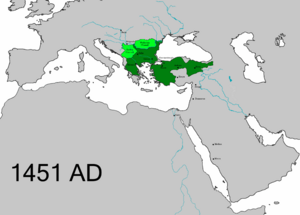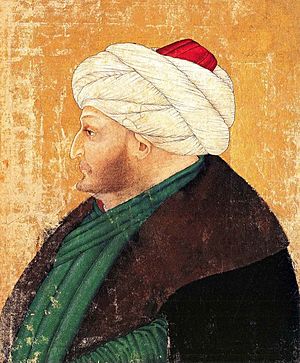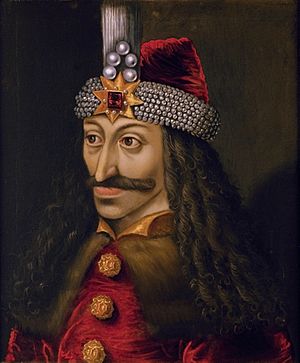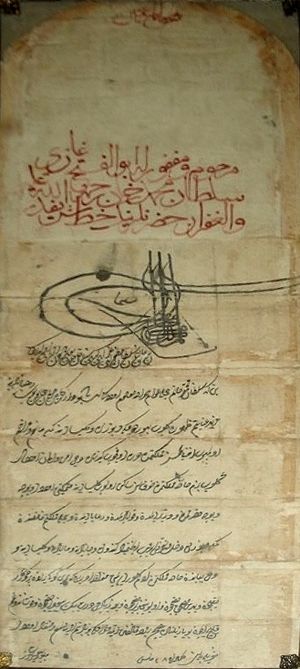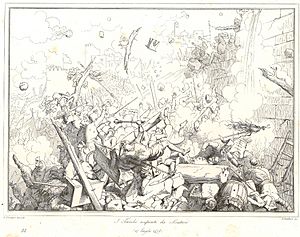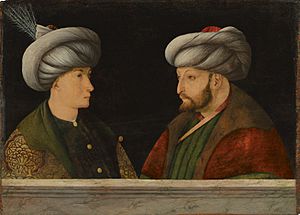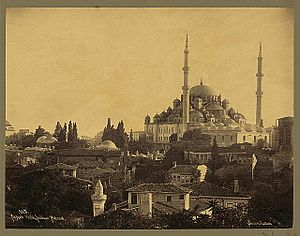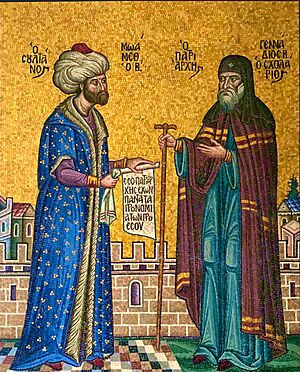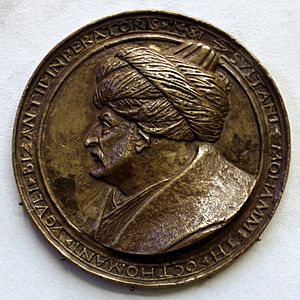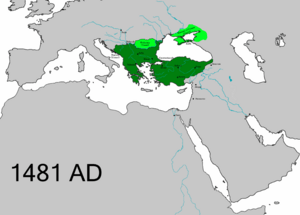Mehmed II facts for kids
Quick facts for kids Mehmed II |
|||||
|---|---|---|---|---|---|
| Kayser-i Rûm (Caesar of the Romans) The Sultan of Two Lands and the Khan of Two Seas |
|||||
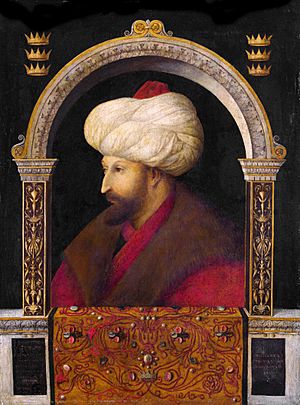
Portrait of Mehmed II by Gentile Bellini,
dating 1480 |
|||||
| Sultan of the Ottoman Empire (Padishah) | |||||
| 1st reign | August 1444 – September 1446 | ||||
| Predecessor | Murad II | ||||
| Successor | Murad II | ||||
| 2nd reign | 3 February 1451 – 3 May 1481 | ||||
| Predecessor | Murad II | ||||
| Successor | Bayezid II | ||||
| Born | 30 March 1432 Edirne, Ottoman Sultanate |
||||
| Died | 3 May 1481 (aged 49) Hünkârçayırı (Tekfurçayırı), near Gebze, Ottoman Empire |
||||
| Burial | Fatih Mosque, Istanbul, Turkey | ||||
| Consorts |
|
||||
| Issue |
|
||||
|
|||||
| Dynasty | Ottoman | ||||
| Father | Murad II | ||||
| Mother | Hüma Hatun (biological) Mara Branković (adoptive) |
||||
| Religion | Sunni Islam | ||||
| Tughra |  |
||||
Mehmed II (born March 30, 1432 – died May 3, 1481), also known as Mehmed the Conqueror, was an important Ottoman sultan. He ruled the Ottoman Empire twice: first from August 1444 to September 1446, and then again from February 1451 to May 1481.
During his first time as sultan, Mehmed II defeated a large army led by John Hunyadi. This happened after Hungary broke a peace agreement. When Mehmed II became sultan again in 1451, he made the Ottoman navy stronger. He also got ready to attack Constantinople, a very important city.
At just 21 years old, Mehmed II successfully conquered Constantinople in 1453. This event marked the end of the Byzantine Empire. After his victory, Mehmed claimed the title of Caesar of the Roman Empire. He believed the Ottoman state was a continuation of the Roman Empire.
Mehmed continued to expand his empire. He took control of more lands in Anatolia and in Southeast Europe, reaching as far as Bosnia. At home, he made many changes to the government and society. He supported art and science. By the end of his rule, his efforts had transformed Constantinople into a busy and grand capital city. Today, Mehmed II is seen as a hero in Turkey and other parts of the Islamic world. Many places are named after him, like the Fatih district in Istanbul and the Fatih Sultan Mehmet Bridge.
Contents
Early Life and First Reign
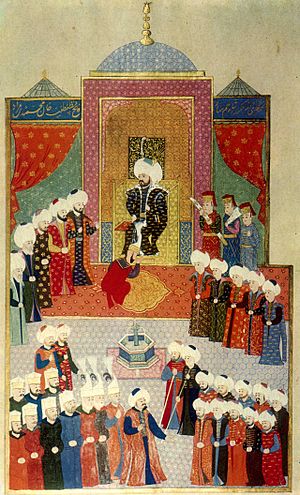
Mehmed II was born on March 30, 1432, in Edirne. At that time, Edirne was the capital city of the Ottoman Empire. His father was Sultan Murad II, and his mother was Hüma Hatun.
When Mehmed was eleven, he was sent to Amasya. This was a common practice for Ottoman princes. He went there with his advisors, called lalas, to learn how to govern. Sultan Murad II also made sure Mehmed had many teachers. This education, especially in Islamic studies, greatly shaped Mehmed's way of thinking. He was taught to believe it was his duty to conquer the Byzantine Empire and its capital, Constantinople.
In June 1444, Sultan Murad II made peace with Hungary. Soon after, in July or August 1444, he gave up his throne to his 12-year-old son, Mehmed II.
During his first time as sultan, Mehmed II faced a challenge. A crusade, or religious war, led by John Hunyadi attacked his country. This happened because the Hungarians broke a peace treaty. Mehmed II defeated this crusade in September 1444. Some stories say Mehmed asked his father, Murad II, to return and lead the army. Murad II did return and won the Battle of Varna on November 10, 1444.
In 1446, Murad II became sultan again. Mehmed II still had the title of sultan but acted as a governor. After Murad II died in 1451, Mehmed II became sultan for the second time.
Major Conquests
Conquering Constantinople

When Mehmed II became sultan again in 1451, he focused on building a strong navy. He also started preparing to attack Constantinople. He built a very strong fortress called Rumelihisarı on the European side of the Bosphorus Straits. This fortress, along with an older one, gave him full control of the strait. Mehmed then started charging a toll for ships passing through. If a ship didn't stop, it was sunk.
In 1453, Mehmed began the siege of Constantinople. His army had between 80,000 and 200,000 soldiers. He also had over seventy large cannons and a navy of 320 ships. The city was surrounded by land and sea. The siege began in early April. The city's strong walls held off the Ottoman army at first. Mehmed's army used a new, giant cannon called the Dardanelles Gun.
The harbor of the Golden Horn was blocked by a large chain. On April 22, Mehmed did something amazing. He moved his lighter warships over land, around the city of Galata, and into the Golden Horn. Eighty ships were moved over a mile of wooden path. This forced the Byzantines to spread out their defenders. About a month later, on May 29, Constantinople fell after a 57-day siege. After this victory, Mehmed moved the Ottoman capital from Edirne to Constantinople.
After conquering Constantinople, Mehmed claimed the title of Caesar of the Roman Empire. He believed that since Constantinople was the capital of the Roman Empire, he was its rightful ruler. The Eastern Orthodox Church recognized his claim. Mehmed appointed Gennadius Scholarius as the new leader of the Orthodox Christians.
Mehmed also conquered the Despotate of Morea in 1460 and the Empire of Trebizond in 1461. These were the last parts of the Byzantine Empire. Some historians say that Mehmed visited Troy after his conquests. He reportedly felt he had avenged the Trojans by conquering the Greeks.

Campaigns in Serbia
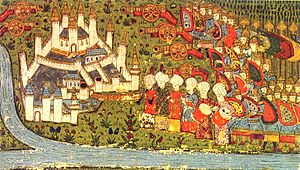
After conquering Constantinople, Mehmed II turned his attention to Serbia. Serbia had been a vassal state, meaning it paid tribute to the Ottomans. Mehmed had a connection to Serbia because one of his father's wives was Mara Branković. However, Serbia had allied with Hungary and was not paying tribute regularly.
In 1454, the Ottoman army marched towards Serbia. They besieged Smederevo and Novo Brdo, an important mining center. Ottomans and Hungarians fought for several years. The Ottoman army reached Belgrade in 1456. They tried to conquer the city from John Hunyadi but failed in the Battle of Belgrade on July 14, 1456.
A period of peace followed. Serbia remained independent for only two more years after its ruler, Đurađ Branković, died. In 1459, Mehmed sent his army and captured Smederevo. This ended the independence of the Serbian Despotate.
Conquering Morea
The Despotate of the Morea was a region in southern Greece. The Ottomans had already attacked this area before. In 1446, they destroyed the Hexamilion wall, a defense at the Isthmus of Corinth.
Before the final siege of Constantinople, Mehmed ordered his troops to attack Morea. The local rulers, Demetrios Palaiologos and Thomas Palaiologos, were brothers of the last Byzantine emperor. They were not good rulers and faced a revolt from their own people. They even asked Ottoman troops to help them put down the revolt.
In May 1460, Mehmed entered Morea. The rulers had failed to pay their yearly tribute to the Sultan. The capital city, Mistra, fell on May 29, 1460, exactly seven years after Constantinople. By the end of the summer, the Ottomans had taken control of almost all Greek cities in the region.
Some areas held out longer. The island of Monemvasia refused to surrender. The Mani Peninsula in the south resisted under local clans. The last place to fall was Salmeniko in the northwest. Its commander, Graitzas Palaiologos, and his soldiers held out in a castle until July 1461 before escaping.
Conquering Trebizond
The Empire of Trebizond was a small empire in northeastern Anatolia. Its rulers had made alliances with other Muslim leaders through marriages. They hoped to get help against the Ottomans. The Ottomans had tried to capture Trebizond before, but failed. In 1456, an Ottoman governor attacked Trebizond and forced them to pay a heavy tribute.
After the ruler of Trebizond died in 1459, his brother David took power. David tried to get help from European countries against the Ottomans. He even talked about conquering Jerusalem. Mehmed II heard about these plans. David also demanded that Mehmed cancel the tribute.
Mehmed the Conqueror responded in the summer of 1461. He led a large army by land and his navy by sea. He first captured Sinope, ending the rule of a local dynasty there. Mehmed then quickly moved to Trebizond. He surrounded the city, and it held out for a month. Emperor David surrendered on August 15, 1461.
Wallachia and Vlad the Impaler
Since the early 1400s, the Ottomans tried to control Wallachia, a region north of the Danube River. Wallachia was important as a buffer zone between the Ottomans and the Kingdom of Hungary. The Ottomans usually let Wallachia rule itself in exchange for a yearly tribute.
To prevent Wallachia from becoming too close to Hungary, the Ottomans released a young prince named Vlad III (also known as Dracula). Vlad had been a prisoner of Murad II. The Ottomans hoped Vlad would become their ruler in Wallachia. However, his rule was short.
In 1456, Vlad III returned to Wallachia and became its ruler. In 1459, Mehmed II sent messengers to Vlad. He wanted Vlad to pay a delayed tribute of money and soldiers. Vlad III refused and had the Ottoman messengers killed.
Mehmed then sent an army to deal with Vlad. Vlad III set a trap, and most of the Ottoman soldiers were captured and impaled. In the winter of 1462, Vlad III crossed the Danube River. He burned the land in Bulgaria and attacked Ottoman camps.
Mehmed II himself led a large army into Wallachia. Vlad III launched a surprise night attack on the Ottoman camp. This caused many casualties for the Ottomans. However, Vlad's harsh methods were not popular with everyone. He was betrayed by some local nobles. The Ottomans captured the Wallachian capital, Târgoviște. Mehmed II left Vlad's brother, Radu, as the new ruler of Wallachia. Vlad escaped to Hungary.
Conquering Bosnia
After the ruler of Serbia died in 1458, a civil war started. This led to the Ottoman conquest of Serbia in 1459. Stephen Tomašević, the son of the King of Bosnia, tried to take control of Serbia. But Ottoman forces made him give up his plan. Bosnia then became a kingdom that paid tribute to the Ottomans.
In 1461, Stephen Thomas died, and Stephen Tomašević became King of Bosnia. He made an alliance with Hungary and asked the Pope for help against an Ottoman invasion. In 1463, after a disagreement about the yearly tribute, he asked the Venetians for help. But no help arrived.
In 1463, Sultan Mehmed II led an army into Bosnia. The royal city of Bobovac quickly fell. Stephen Tomašević retreated to Jajce and then to Ključ. Mehmed conquered Bosnia very quickly. He had Stephen Tomašević executed. Bosnia officially fell in 1463. It became the westernmost part of the Ottoman Empire.
War with Venice
A long war between the Ottomans and the Republic of Venice began in 1463. It started after an Albanian slave, who had stolen money from an Ottoman commander, fled to a Venetian fortress. The Venetians refused to hand him over. In November 1462, an Ottoman commander attacked a Venetian fortress. In April 1463, the Ottomans also took the Venetian town of Argos.
A new alliance formed against the Ottomans. Venice sent an army to Morea, and Matthias Corvinus invaded Bosnia. The Pope also planned to lead an army. In August, the Venetians retook Argos and rebuilt the Hexamilion wall. But they suffered a major defeat in October and had to retreat. In Bosnia, Matthias Corvinus captured many forts, including the capital Jajce.
The Ottomans reacted quickly. Mehmed II sent his Grand Vizier, Mahmud Pasha Angelović, against the Venetians. The Ottomans destroyed the Hexamilion wall and advanced into Morea. Sultan Mehmed II then went to Bosnia to help retake Jajce, but he failed. The death of the Pope ended the larger crusade.
The war continued with small battles and raids. In 1470, Mehmed personally led an army to besiege Negroponte, a Venetian island. The Venetian navy was defeated, and Negroponte was captured.
In 1466, Mehmed marched against the Albanians, led by Skanderbeg. Skanderbeg had resisted the Ottomans for a long time. Mehmed built a new fortress called Elbasan to cut Albania in half. Skanderbeg died in 1468. After his death, the Albanians struggled to find a new leader. Mehmed II eventually conquered Krujë and all of Albania in 1478.
The war with Venice ended with the Treaty of Constantinople (1479). Venice gave up Shkodra and other territories. They also lost the Greek islands of Euboea and Lemnos. Venice had to pay a large sum of money and a yearly tribute to trade in the Black Sea. This treaty weakened Venice's position in the region.
Anatolian Conquests
After the Seljuks in Anatolia, many smaller Turkish states, called Anatolian beyliks, appeared. The Karamanids were the most powerful. But by the late 1300s, the Ottomans started to control most of Anatolia.
The ruler of Karaman, İbrahim II of Karaman, died, and his sons fought for the throne. One son, Pir Ahmet, asked Sultan Mehmed II for help. In return, Pir Ahmet promised to give Mehmed some land. With Ottoman help, Pir Ahmet defeated his brother. Pir Ahmet kept his promise but later tried to take back the land. Mehmed returned and captured both Karaman and Konya in 1466.
Pir Ahmet escaped and got help from Uzun Hasan, the ruler of the White Sheep Turcomans. In 1472, the White Sheep army invaded Anatolia. But Mehmed led a successful campaign against Uzun Hasan in 1473. This resulted in a big Ottoman victory at the Battle of Otlukbeli. Pir Ahmet tried to regain Karaman but was defeated again. He eventually gave up and died in 1474.
Mehmed II brought many of these Turkish states under Ottoman control. This allowed him to expand his empire further into Europe.
War with Moldavia
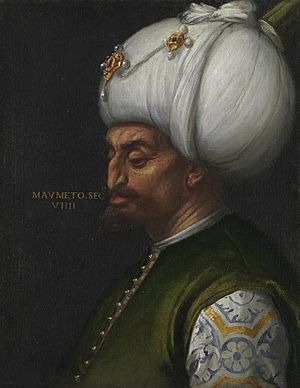
In 1456, Peter III Aaron of Moldavia agreed to pay the Ottomans a yearly tribute. This made him the first Moldavian ruler to accept Ottoman demands. However, his successor, Stephen the Great, refused to accept Ottoman rule. This led to a series of fierce wars.
Stephen tried to control Wallachia and supported his own choice for its ruler. This caused ongoing conflicts between Wallachian rulers supported by Hungary, the Ottomans, and Stephen. In 1475, an Ottoman army was sent to punish Stephen. But the Ottomans suffered a huge defeat at the Battle of Vaslui. This was described as a great victory for the Christian forces against the Ottomans.
In June 1476, Mehmed II gathered a large army and entered Moldavia. Groups of Crimean Tatars, who were Ottoman allies, also attacked Moldavia. Stephen tried to avoid a direct battle and used a "scorched-earth" tactic, burning everything so the Ottomans couldn't find supplies.
Finally, Stephen faced the Ottomans in battle. The Moldavians lured the main Ottoman forces into a forest and set it on fire, causing many casualties. The Moldavian army used hand-guns to push back Ottoman attacks. Seeing his forces struggling, Mehmed personally led his guards into the fight. This helped rally the Ottoman soldiers.
The Moldavian army was defeated, and many soldiers died on both sides. The battlefield was said to be covered with bones. Stephen the Great retreated to gather another army. The Ottomans could not capture any major Moldavian strongholds. They also faced starvation and an outbreak of plague. So, the Ottoman army returned home. Stephen continued to challenge Ottoman influence in Wallachia for decades.
Crimean Policy
A group of Turkic people called the Crimean Tatars lived in the Crimean Khanate. After the Golden Horde empire fell, the Crimean Tatars formed their own independent state. They controlled the steppes but not the rich trading towns controlled by the Genoese.
After Mehmed conquered Constantinople, the Genoese trade routes were disrupted. The Crimean Tatars asked the Ottomans for help. In 1475, Gedik Ahmed Pasha led an Ottoman invasion of the Genoese towns. He captured Kaffa and other trading centers.
After this, the Ottoman Sultan held the Crimean Khan, Meñli I Giray, captive. He was later released after agreeing to accept Ottoman rule. The Crimean Khans became tributary princes, meaning they paid tribute to the Ottomans. They still had a lot of freedom, but the Ottomans directly controlled the southern coast.
Expedition to Italy
In 1480, an Ottoman army led by Gedik Ahmed Pasha invaded Italy. They captured the city of Otranto. Because of a lack of food, Gedik Ahmed Pasha returned to Albania with most of his troops. He left a small group of soldiers to defend Otranto. He planned to return after winter.
Since Constantinople had fallen only 28 years earlier, there was fear that Rome might also be conquered. Plans were made for the Pope and the people of Rome to leave the city. Pope Sixtus IV called for a new crusade. Several Italian states, Hungary, and France agreed to help. The Republic of Venice did not, as they had just signed an expensive peace treaty with the Ottomans.
In 1481, King Ferdinand I of Naples raised an army. The city of Otranto was besieged starting May 1, 1481. Mehmed II died on May 3. The disagreements about who would be the next sultan likely stopped the Ottomans from sending more soldiers to Otranto. The Ottoman occupation of Otranto ended through talks with the Christian forces. The Ottoman soldiers were allowed to return to Albania. Otranto was retaken by Papal forces in 1481.
Rebuilding Constantinople
After conquering Constantinople, Mehmed II rode his horse to the Hagia Sophia. He ordered that the building be protected. He then had a Muslim prayer called the Shahada recited there. The Orthodox cathedral was turned into a Muslim mosque. This showed that Islamic rule was now firm in Constantinople.
Mehmed's main goal was to rebuild and repopulate the city. Building projects started right away. This included repairing the city walls and building a new palace, the Topkapı Palace. He also built a hospital, a cultural center, and barracks for his soldiers. To encourage people to return, he gave back houses to Greeks and Genoese who had fled. He also promised them safety.
Mehmed ordered that Muslims, Christians, and Jews from across his empire move to Constantinople. Prisoners of war and deported people were sent to the city. Mehmed also brought back the Orthodox Patriarchate and established a Jewish Grand Rabbinate. He also founded the Armenian Patriarchate of Constantinople. This was part of the millet system, which allowed different religious communities to govern themselves.
Mehmed also encouraged his officials to build Muslim institutions and businesses in Constantinople. The city grew quickly. By 1478, Constantinople and nearby Galata had over 16,000 households and 3,900 shops. The population was estimated at 80,000 people. About 60% were Muslim, 20% Christian, and 10% Jewish.
By the end of his rule, Mehmed's ambitious rebuilding plans had turned Constantinople into a thriving imperial capital. Fifty years later, it was the largest city in Europe again.
Government and Culture
Mehmed II was very interested in learning and culture. He invited Italian artists, scholars, and Greek thinkers to his court. He allowed the Eastern Orthodox Church to continue. He asked the patriarch Gennadius Scholarius to translate Christian teachings into Turkish. He also invited the famous Italian artist Gentile Bellini to paint his portrait.
Mehmed built a large library in his palace. It had over 8,000 books in many languages, including Greek, Persian, and Latin. He also invited Muslim scientists and astronomers like Ali Qushji to his court. He started a university and built many mosques, including the Fatih Mosque. Around the Fatih Mosque, he built eight schools, called madrasas. These schools were top centers for Islamic studies for almost a century.
Mehmed II gave his subjects a good amount of religious freedom. This was as long as they obeyed his rule. After conquering Bosnia in 1463, he issued a special document called the Ahdname of Milodraž. This document granted the Bosnian Franciscans freedom to travel, worship in their churches, and practice their religion without being bothered.
However, his army was partly recruited through the Devshirme system. This system took young Christian boys (aged 8–20). They were converted to Islam and trained for government or military roles as Janissaries. This system helped create a government based on skill, not family background.
Centralizing the Government
Mehmed the Conqueror made the government stronger by creating an imperial court. Its officials were loyal only to him. This gave him more power and control. Before Mehmed, the court often had members from powerful families. These families sometimes had their own interests. Mehmed changed the empire from a frontier society to a centralized government. He appointed officials who came from the devşirme system, not from noble families.
Mehmed also made religious scholars, who worked in the Ottoman schools, paid employees of the government. This made them loyal to him. He made new laws, called kanunname, between 1477 and 1481. These laws listed the main government officials, their jobs, salaries, and rules. This was the first time a sultan could make such laws based on his own power.
Mehmed gave more power to his chief ministers, called viziers. He delegated important government tasks to them. He also became less accessible to the public. A wall was built around the palace, making it more private. His viziers managed the military and met with foreign ambassadors. These were key roles, especially with Mehmed's many military campaigns.
Supporting Renaissance Art
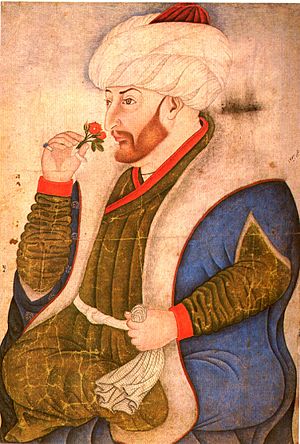
Mehmed II was very interested in Western art and literature. He collected many works by Renaissance artists. From a young age, Mehmed showed interest in Renaissance art and ancient Greek and Roman history. His school books even had drawings in a European style. He reportedly had two teachers, one for Greek and one for Latin. They read him classical histories before the fall of Constantinople.
Early in his rule, Mehmed started supporting Italian Renaissance artists. He invited famous artists like Costanzo da Ferrara and Gentile Bellini to his court.
Besides art, Mehmed was also a keen scholar of old and new literature and history. He built a huge library with over 8,000 manuscripts. These books were in many languages, including Persian, Ottoman Turkish, Arabic, Latin, and Greek. His Greek collection included copies of famous works like Homer's Iliad. He also supported Greek writers.
Historians believe Mehmed's interest in Western culture had important diplomatic and administrative uses. His support for Renaissance artists helped him with diplomacy with Italian states. His Greek library might have been used to train Greek officials. These officials could then communicate with Italian states in Greek. Historians also think his art collection helped show his power and right to rule. He wanted to present himself as a Western-oriented ruler, like European Christian kings.
However, not everyone in his court supported Mehmed's interest in Renaissance art. His own son, Bayezid II, was against it. When Bayezid II became sultan, he sold Mehmed's collection of portraits and statues.
Family Life
Mehmed II had at least eight known wives or partners. He was the last sultan to legally marry until Suleiman the Magnificent in the 1500s.
Wives and Partners
- Gülbahar Hatun: Mother of Bayezid II.
- Gülşah Hatun: Mother of Şehzade Mustafa.
- Sittişah Mukrime Hatun: His first legal wife. She was the daughter of a ruler from another Turkish state. Their marriage was not happy and they had no children.
- Çiçek Hatun: Mother of Cem Sultan.
- Anna Hatun: Daughter of the Greek emperor of Trebizond. She entered Mehmed's palace after Trebizond was conquered. She later married Zaganos Mehmed Pasha.
- Helena Hatun: Daughter of the ruler of Morea. Mehmed wanted her after his conquest of Morea. She was likely his second legal wife.
- Maria Hatun: She was the widow of a prince from Trebizond. She was considered very beautiful.
- Hatice Hatun: Daughter of Zaganos Mehmed Pasha. She likely became Mehmed's third legal wife in 1463.
Sons
Mehmed II had at least four sons:
- Bayezid II (born 1447 – died 1512): Son of Gülbahar Hatun. He became the next Ottoman Sultan.
- Şehzade Mustafa (born 1450 – died 1474): Son of Gülşah Hatun. He was a governor and his father's favorite son.
- Şehzade Cem (born 1459 – died 1495): Son of Çiçek Hatun. He became governor after his brother Mustafa died. He fought against his half-brother Bayezid for the throne. He died in exile.
- Şehzade Nureddin: Likely died as a baby.
Daughters
Mehmed II had at least four daughters:
- Gevherhan Hatun (born 1446 – died 1514): Daughter of Gülbahar Hatun.
- Ayşe Hatun.
- Kamerhan Hatun: She married Hasan Bey. They had a daughter named Hanzade Hatun.
- Fülane Hatun.
Personal Interests
Mehmed had a strong interest in ancient Greek and Byzantine history. His heroes were Achilles and Alexander the Great. He could discuss Christian religion well. He was known to speak several languages, including Turkish, Serbian, Arabic, Persian, Greek, and Latin.
He sometimes brought together learned Muslim teachers, called Ulama. He had them discuss religious topics in front of him. During his rule, studies in mathematics, astronomy, and theology reached high levels among the Ottomans. He was friends with scholars and thinkers. He ordered that the Parthenon and other ancient buildings in Athens not be destroyed. Mehmed II was also a poet himself. He wrote poetry under the name "Avni."
Death and Legacy
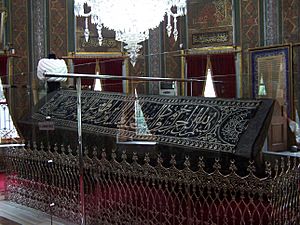
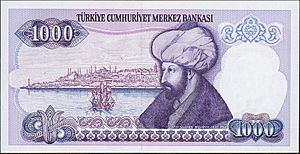
In 1481, Mehmed marched with the Ottoman army. But he became ill when he reached Maltepe, Istanbul. He was planning new campaigns to capture Rhodes and southern Italy. Some historians believe his next goal was to conquer Egypt.
Mehmed II died on May 3, 1481, at the age of 49. He was buried in his tomb near the Fatih Mosque complex in Istanbul. Some historians think Mehmed was poisoned. This might have been done by his oldest son and successor, Bayezid.
News of Mehmed's death brought great joy in Europe. Church bells rang, and celebrations were held. In Venice, people announced, "The Great Eagle is dead!"
Mehmed II is known as the first sultan to write down criminal and constitutional laws. This happened long before Suleiman the Magnificent. He created the classic image of a powerful Ottoman sultan. Mehmed's 30-year rule and many wars greatly expanded the Ottoman Empire. He added Constantinople, Turkish lands in Asia Minor, Bosnia, Serbia, and Albania to the empire.
Mehmed left a lasting impression in both the Islamic and Christian worlds. The Fatih Sultan Mehmet Bridge in Istanbul, completed in 1988, is named after him. His name and picture also appeared on the Turkish 1000 lira note from 1986 to 1992.
See also
 In Spanish: Mehmed II para niños
In Spanish: Mehmed II para niños
- Classical Age of the Ottoman Empire
- Decline of the Byzantine Empire


